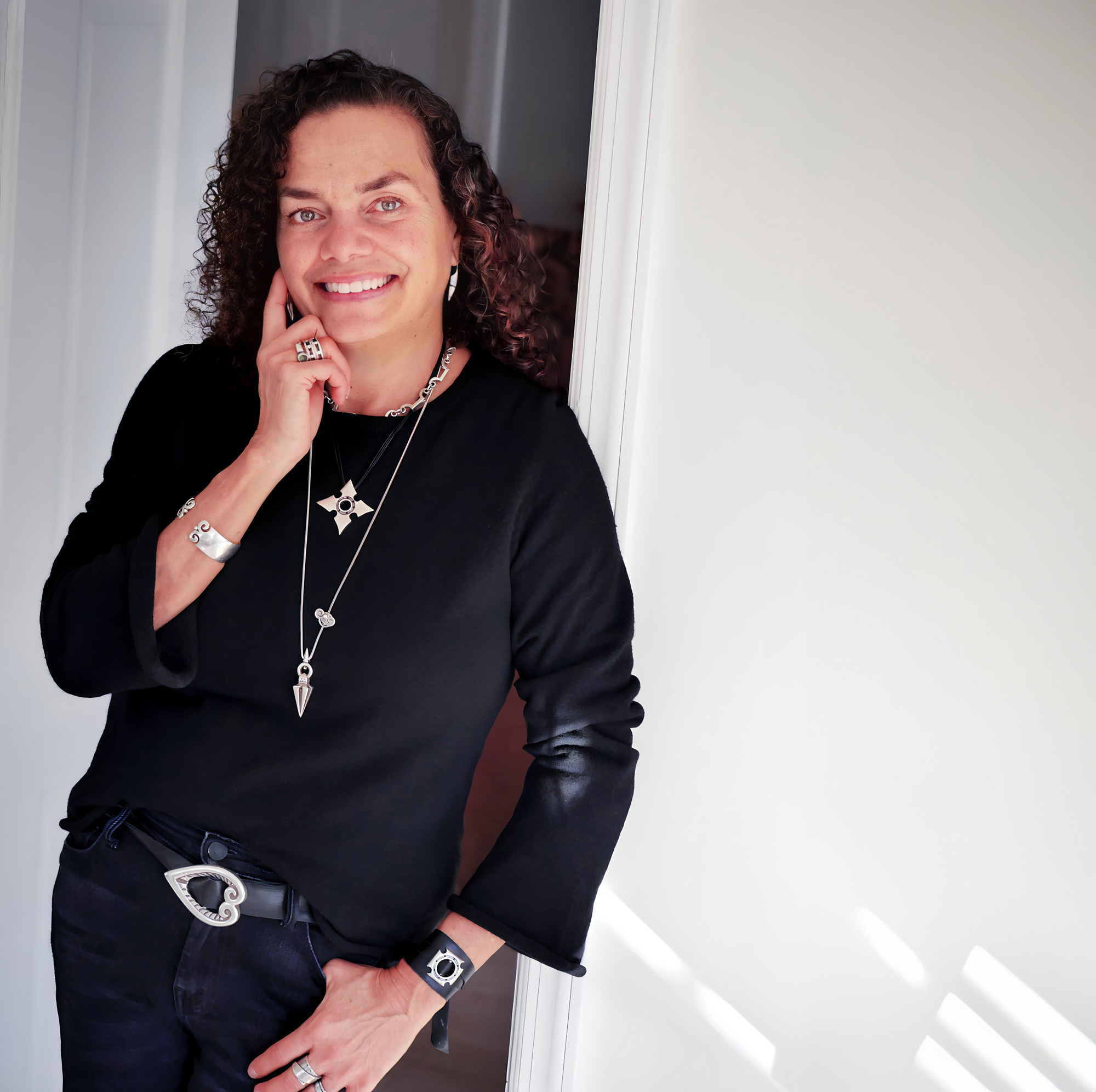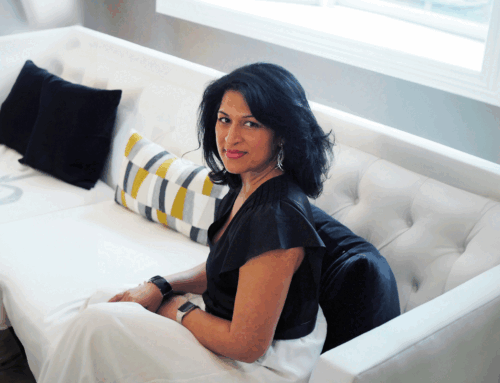Writing by Amy Baker
Photography by Justin Negard
In the mid-1990s, jewelry designer Cynthia Ryan created her first Lunette ring while enrolled in a beginner’s jewelry-making course at the Fashion Institute of New York. Her professor was amazed.
“What exactly do you do during the day,” he asked. “Your design is a different approach than most, more architectural and reminiscent of European designers.”
Then, he encouraged her to create an entire line. So she did.
Ryan describes her jewelry as bold, sculptural, three-dimensional and architecturally inspired. Most of the pieces are sterling silver, but she offers a few items in 18-karat gold vermeil – a specific technique that plates gold over silver.
“My jewelry has a nice weight to it, and it feels good on,” she explains. “It can go from day to night. You can wear it to a black-tie event or with a t-shirt and jeans. The designs are gender-neutral and can be stacked and layered to create your personal style.”
Ryan’s jewelry reveals architectural details that speak to her: spires, circles, pendulums, gates and metalwork. The scroll form plays a leading role in many of her pieces, including the sterling clasp on many of the necklaces. Her Astragal Stacking Band features dots and lines reminiscent of chair designs by architect Josef Hoffman, founder of the Wiener Werkstätte movement (think of Gustav Klimt), which Ryan admires. Her logo nods to the style of that era as well.
An eye for detail
Architecture proved an integral source of creative inspiration for young Ryan. She enjoyed exploring the neighborhoods around her childhood home located on the Upper West Side of Manhattan, discovering embellished facades, spires and scrollwork, and capturing them in her sketchbook.
“I loved growing up in the city,” she says. “I loved the buildings and the architecture. Growing up in a pre-war building, we had old mantle pieces and beautiful plaster work inside, and then outside, there were finials and so many other things to focus on. I was always intrigued by architectural details.”
Her home life was filled with many artistic endeavors, which she says inspired the artist she is today.
“My dad played professionally in a big band before writing comedy for TV,” she remembers. “His friends used to come over for dinner parties, and they would all play and sing, with my brother joining them on the drums. My father and I would compete to see who could play the beginning of Scott Joplin’s Maple Leaf Rag faster without making any mistakes. He clearly had the upper hand, but we had fun.”
That grand piano now resides in Ryan’s South Salem home, and it’s a family heirloom. It originally belonged to her grandmother, who played it for silent movies.
Ryan was accepted into both the High School of Music & Art and the School of Performing Arts, now combined into one high school — Fiorello H. LaGuardia High School of Music & Art and Performing Arts. She chose the High School of Music & Art and studied both art and architecture.
But it was architecture that ultimately spoke to Ryan. She earned her bachelor’s of art degree from the University of Pennsylvania with a major in design of the environment and a minor in art history, and she originally planned to pursue a master’s degree in architecture. However, following a summer internship with the esteemed architectural firm Marcel Breuer (you may know his work from such buildings as the old Whitney Museum on Madison Avenue), she realized the career was not for her. She scrapped her postgraduate plans, which gave her the opportunity for optional courses in her senior year.
“I took a class where I actually drew buildings with charcoal on canvas,” she remembers. “And I started drawing them without any straight lines. It was all based on value and shadow. My professor said it was amazing, and I thought, Okay, but now what?”
Ryan found work in the visual merchandising department at Macy’s, designing brand spaces within the Herald Square store. After a year, she left to work for WalkerGroup/CNI, a top retail design firm at the time. It was more responsibility, and she began by designing a Saks Fifth Avenue store in Tulsa, OK, and then moved on to more specialty and department stores.
“Something I really loved about retail design was that you weren’t just creating something to look pretty…there was this whole thought process behind it, and it had to work,” she says. “You really are drawing the customer in and working to move them wherever the merchandiser wants them to go within the store to sell the product.”
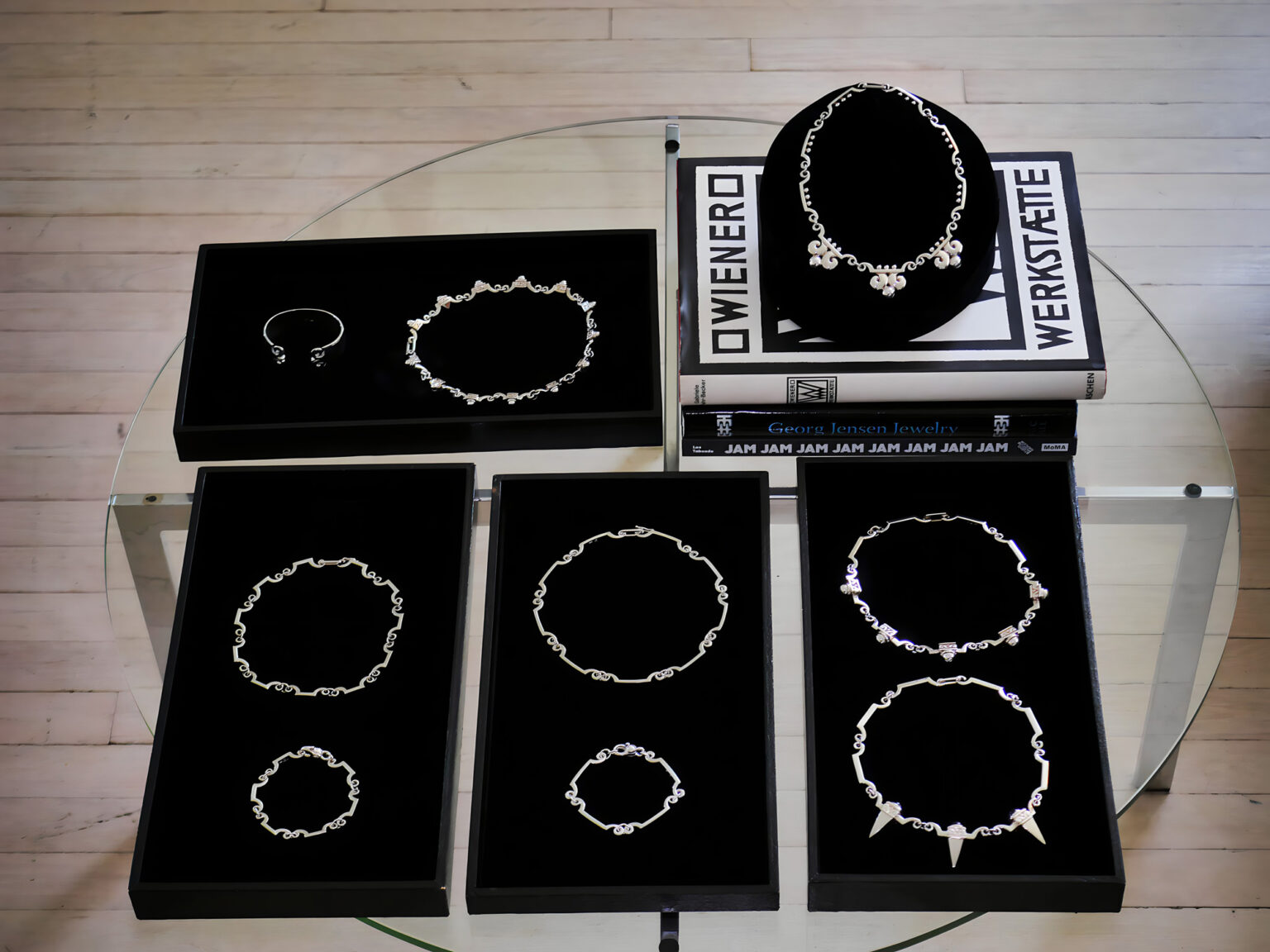
Mastering silver
In the mid-1990s, a friend who knew how much Ryan loved jewelry encouraged her to attend a workshop at the Fashion Institute of Technology in New York with Robert Lee Morris, a designer whom Ryan had long admired. She fondly remembers saving money as a teenager to purchase his pieces. It was during the workshop that she made the decision to learn more about jewelry design, signing up for a course at FIT that evening.
In her first class, she learned how to cut sterling and created two three-dimensional pendants. After that, she learned the lost wax method, creating her first ring, the Lunette, which she still wears and sells today.
“You actually carve your design out of wax and place it inside a flask,” she says. “Then you pour a compound over the wax to create your mold. Once that hardens, you heat the whole thing up, and the wax melts away, leaving you with your mold. Now, melted silver can be added to the mold, which creates the prototype. You can then file, finish and polish it, and add a stone. This is called a bezel set.”
After completing a materials class, Ryan took her professor’s advice to create her first jewelry line. She began drawing her designs and gained additional experience working at a jeweler’s bench for a manufacturing company that created pieces sold at Henri Bendel.
Then she started creating her own line, hiring Danish model-maker Keld Olsen in Providence, RI — the center of jewelry manufacturing in the U.S. — to help her carve the waxes and produce the prototypes for her initial designs. She says Olsen was extremely supportive of her vision.
“Keld trained at Georg Jensen, which also creates three-dimensional designs,” she explains. “I sent him my drawings, and he said, ‘I’ve done 2,000 rings, but I’ve never done rings like this.’”
In 1998, Ryan launched her first line.
“Within a year, I was in Nordstrom in New York and California, along with some smaller stores, and I started talking to Saks,” she recalls.
Saks loved her work, but they pushed her to commit to four full collections per year, a big undertaking for Ryan as she was starting a family around the same time.
“I was designing the collection for Saks, but it got to be a little crazy,” she says. “I was still working in retail design while creating jewelry, and then I was suddenly put on bed rest with my first child. It was a lot.”
Ryan decided to scale back, suppressing her opportunity with Saks Fifth Avenue, a decision that creates many “what if” questions in her mind.
“I sometimes wonder if I should have continued and worked with Saks,” she says. “Would my jewelry be this huge brand now? But we make the choices that are important to us at the time, and you can’t go back. There’s a reason for everything, and every step along the way helps us grow.”
Melding community with design
As her family grew, Ryan continued selling her jewelry to shops in and around her Brooklyn neighborhood until 2002, when her family ventured north, settling in South Salem. Ryan became very involved with her children’s schools, taking on active roles as a class parent, event planning and other projects. She created jewelry designs for fundraisers at Thistlewaithe Learning Center, as well as designing a reading nook within the school. And when Lewisboro Elementary School closed, she created a commemorative pendant featuring a small circle with the inscription “LES,” which the PTA presented to the teachers and administration.
More recently, Ryan became active locally, advocating for racial equity.
“What prompted my involvement, mostly, was the Black Lives Matter movement during the pandemic,” she explains. “The town meetings were now on Zoom, and they were trying to say Black Lives Matter, but there was a lot of controversy over this. So the council members were having trouble actually releasing a statement, even as other towns in the area were releasing their own statements.”
She joined one of the Zoom calls to lend her support to the council member who was trying to publish the statement.
“I was really surprised at how vocal some people were getting,” she remembers. “And I wondered if my family background — there are members who were born enslaved and some who were not, so I’m aware of both white privilege and those who are not white – might kind of alleviate some bias.”
Back in eighth grade, Ryan discovered the impactful significance of her family history. Her speech on diversity was selected for the middle school graduation ceremony held at Carnegie Hall. She was going through the speech with the chairman of the English department, who asked her about her last name.
“He said, ‘You don’t look Irish,’” she remembers. “I said, ‘I’m not. Actually, my great-grandfather was born a slave. His mother was a slave. His father was a German soldier who worked on the plantation. My great-grandfather took the name Ryan from the owner of the plantation.’ And as I was saying this, I could hear his secretary slow down her typing…she was listening.”
The English chairman was amazed and asked if Ryan would consider including that information in her speech. Ryan, however, was nervous about it.
“It was a big deal, because growing up, I didn’t know if I was supposed to say I was black,” she explains. “Would I be accepted?”
Her father, Terry Ryan, was a successful TV comedy writer who was very light-skinned.
“He was afraid of being found out,” she says. “He didn’t want to be the center of attention. He passed for white. But my uncle, his brother, did not, so they had very different life experiences.”
In the end, she decided to add her family history to her speech, ending it with, “All together, I am white, black, German, Danish, French and English, and I bear the lovely Irish name of Ryan.” She remembers several black parents taking her photo.
“After the speech, I remember this white kid coming up to me and saying, ‘I’m black, too.’ And a black kid saying, ‘Hey, sister!’ It was nice…I felt accepted.”
Partly due to that experience, Ryan does not fear speaking out about her race, which she says she felt compelled to do following the Black Lives Matter controversy in Lewisboro.
“It was really important for me to try to instill that we need to respect one another, no matter the background, to have empathy for one another, and to stand up for equity.”
In 2021, Ryan and her neighbors created Equity for All Lewisboro, with the goal of supporting and advocating for residents and families of color in the town and schools.
“First, we created the Juneteenth Celebration, and then we compelled the town board to declare Black Lives Matter in July.”
The Juneteenth event is now an annual town event, though, according to Ryan, it took some time for the town board to agree to it. The first one was put together in 10 days — they were able to find a jazz band, everyone brought food, Ryan created an 80-foot timeline of black history dating back to 1619, and the celebration was well attended.
“It was the most diversified and supportive community event I ever attended,” she remembers. “The town then embraced it, and they wanted to give us an honor for creating the first Juneteenth event here. We said, ‘If you’re going to give it to us, you need to claim Black Lives Matter.’ And they did at the next town meeting.”
In 2023, Ryan co-created and is vice president of the Greater Bedford Chapter of the Westchester Black Women’s Political Caucus. Their goal is to support people of color who run for local office.
The advocacy work transcends to Ryan’s jewelry line as well, with a “Designs for Equity” line created specifically for issues she supports. It features a sterling circle pendant with the words “LOVE” or “PRIDE” engraved on the outside.
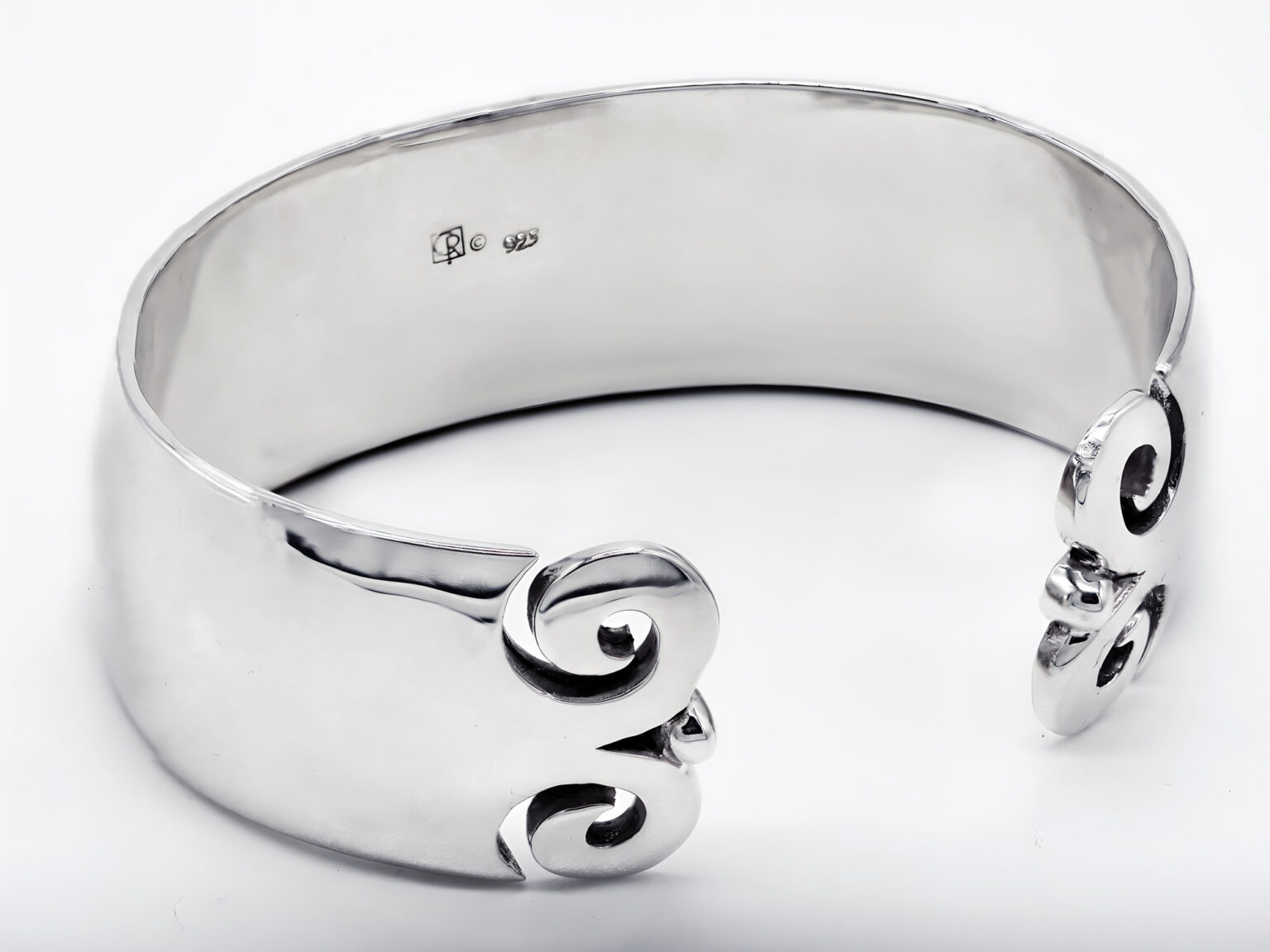
Influences and inspiration
Ryan says her experience producing purposeful retail design often informs her jewelry line.
“In retail design, you create a prototype, a kit of parts, which you can roll out and fit into different layouts,” she explains. “You have your merchandising system. I have that with my jewelry design — I have a kit of parts, like three sizes of circles, which can be singular or all three can neatly fit together. I can add a diamond or a pearl to them. It allows for personal expression for the customer, and I love that.”
As an architectural designer, Ryan enjoys the mathematical aspects of creating jewelry, which force her to look at it as a geometric shape.
“It’s a way to make sense of the piece,” she explains. ”Like with my collars, I need to know the measurement around the neck, and then I’ll know the number of pieces I need, how they’re going to connect and then how to connect them so you can’t see that connection. [The connection should be] fluid so that it becomes a sculptural piece that you wear.”
She’s also inspired by many artists, especially if they create more sculptural works.
“I love Sol LeWitt,” she says, “and also Lygia Clark, a female architect whose work is a perfect example of what inspires me. Actually, many artists I like were trained as architects. Usually, there are geometric shapes to their work.”
Clark’s metal sculptures are very similar to Ryan’s first pendant designs, which Ryan noticed years later when she first viewed Clark’s art in a museum exhibit.
“That’s why I think it’s not just looking at something and feeling inspired,” she says. “There’s something within you that the art speaks to.”
As Ryan evolves as an artist, she says architecture, especially while traveling, continues to guide her.
“I’m leaning towards creating architectural pieces that reference a place,” she says. “As in, ‘This piece is inspired by a gate in Florence, or this piece in Vienna, or this building on the Upper West Side in Manhattan.’”
Positive and negative space are also extremely important to Ryan.
“I love that the negative space in architecture is the space you walk through,” she says. “An artist I like who does that is Richard Serra, with his curved pieces of metal that you can walk through. In jewelry, I love that the negative space can be you or your skin, seen through the circles or holes of the piece. Additionally, the negative space, the outline of the design, the indents…over time, they start to tarnish and become almost more three-dimensional and sculptural.”
Ryan plans to incorporate more pieces with designs located in often underutilized areas, such as the clasp or back sides. She points out her signature sterling cuff as an example that employs her love for negative space, the basic scroll design, and the functionality of good design. Cuffs often flip around the wrist due to the weight, so Ryan created hers with the design on the ends, knowing they would do this, as well as creating negative space through the gap.
Crafting her comeback
Now that Ryan’s two children are grown and starting careers of their own, she is focusing on all aspects of her jewelry design business, including marketing, the website and even photography for the website – photography is yet another creative pursuit for her.
Ryan’s pieces are all handmade. She begins by creating the wax mold by hand in her studio, where she has a jeweler’s bench. She prefers not to use 3D-printed wax models, even though they would speed up the process.
“I almost don’t like things if they are 100 percent symmetrical,” she says. “I just love handmade things – things that you know someone’s hand has touched.”
After the molds are finished, Ryan takes them to the city, where she collaborates with a manufacturer in the jewelry district, and they are cast, finished and polished. She will then complete any final assembly required in her home studio in Lewisboro. From order placement to completion, the pieces usually take around two weeks, though custom-engraved pieces require a couple more weeks.
Ryan’s jewelry is available at Beehive Design Collective in Mount Kisco, and she is talking to other local stores as well. She says she hopes to eventually see her line sold at a museum gift shop.
“I would really love to grow it as a luxury brand,” she explains. “The response I receive is pretty strong, and I would love to get it out there and give it that chance.”
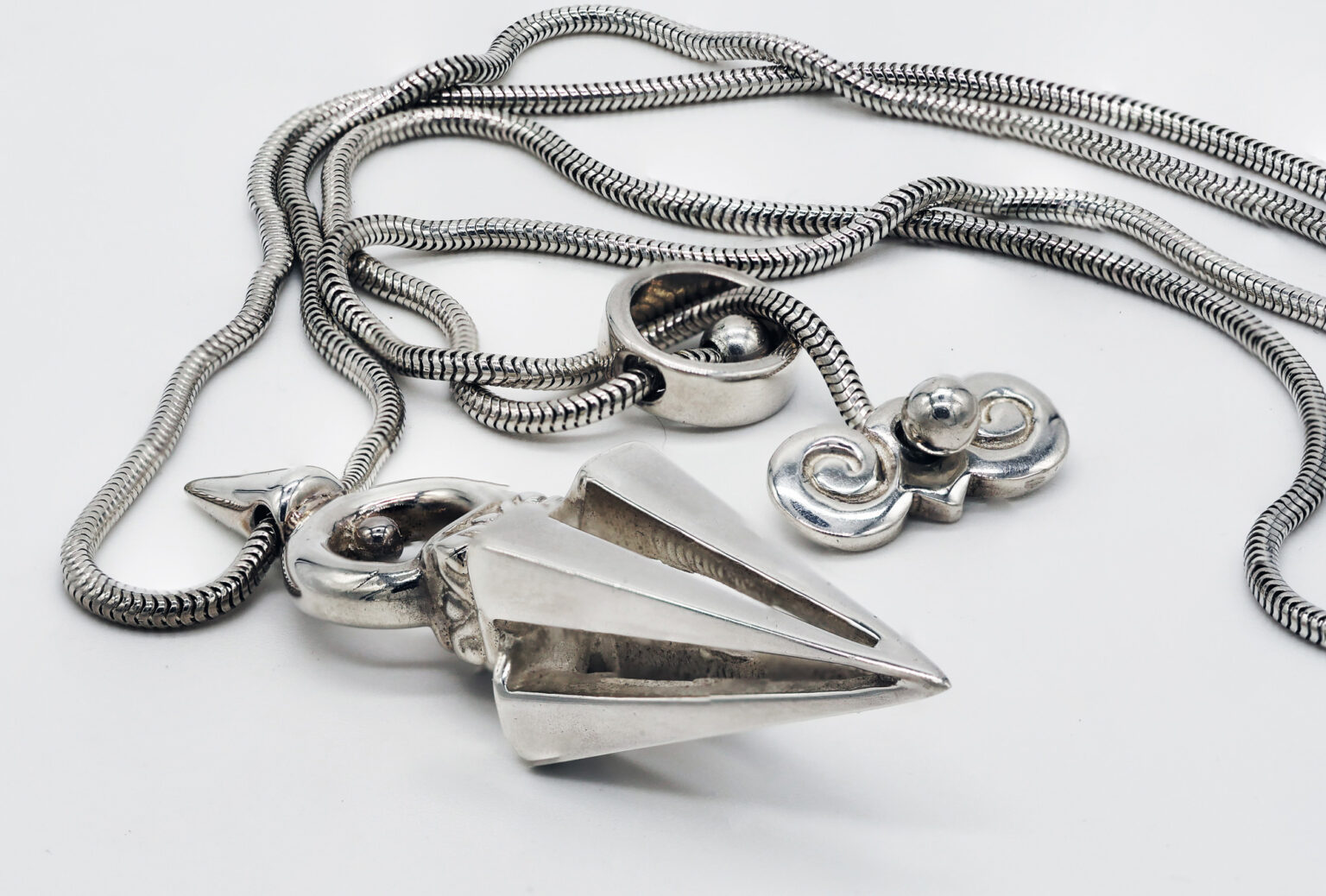
This article was published in the January/February 2024 print edition of Connect to Northern Westchester.
Amy Baker
Amy Baker is a Katonah-based freelance writer who forged her journey in 2006 with USA Today, after finding herself stranded with two young kids at Heathrow airport following a thwarted terrorist attack. An avid international traveler before and since, her globetrotting adventures to off-the-path destinations (Iraq, Brunei, etc.) sparked a passion for photography, which she showcases via her blog, Little Travelers Notebook. “The beauty of travel, beyond the gorgeous landscapes and cuisines, are the fascinating people I’ve met and all their stories,” she says.


